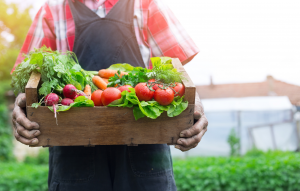Bridging the gap between farm and table

As a student at the George Washington University (GWU), I’ve had the privilege to attend classes taught by Dr. Kathleen Merrigan, former Deputy Secretary of Agriculture and current Executive Director of Sustainability at GWU.
I recently reconnected with Dr. Merrigan at a Washington, D.C. event called Transformers: Food, where she spoke on a panel about how technology and science are changing agriculture, revolutionizing modern food systems and changing the way we consume food.
Afterward, we sat down to talk about how farmers and consumers are adapting to these changes, and what we can look forward to as new movements arise.
At the Transformers: Food event, you mentioned that our society has recently become fixated with food and agriculture. What do you think has fueled this fascination?
It’s definitely not one thing – it’s a bunch of factors coming together to accelerate interest. People are certainly more aware of what they are putting in their mouths because of the news – food recalls, E.coli in chain restaurants, and the obesity crisis, to name a few – and because they want the best for themselves and their families.
But there are also positive factors that come out of this increased awareness. Millennials are thinking about food differently and wanting to create an identity with food. People of all ages are starting to crave authenticity. There’s a chasm between people who produce food and the people who eat it – and this distance is felt across America. You go to a farmer’s market or a food festival and it’s not all about procuring that special head of lettuce or finding the freshest strawberries, but rather about coming together, watching the kids getting their faces painted, listening to local music and enjoying good company.
[Tweet “@katmerrigan craves food with a story – and so does the rest of Americahttps://edf.org/8Rq”]
Throughout your career you’ve been a strong proponent of connecting people to the food they eat. Why is it so important for people to know where their food comes from?
Connecting people to their food will help solve the “policy problem.” I worry that we create policies that aren’t tied back to the farmer, the rancher, the processor and the distributor. The lack of connection and lack of literacy around food production could lead and has led to bad policy.
Connecting people to their food could spearhead better policies that will improve health, while also benefiting farmers and others along the supply chain. Personally, it’s been enriching to know our farmers, to have that connection, and to look at food in a deeper and more interesting way. It’s not just sustenance; it’s not just delicious – it’s food with a story. And I think I’m not alone in craving food with a story.
I imagine most of the farmers you know are local and small-scale. What about larger farms, thousands of miles away?

Yes, it’s just as important for people to connect to large farms. Sometimes we over romanticize the small local farmer. They’re great ambassadors of the farming community, but the reality is that most of our food comes from vast, large-scale enterprises. We need to focus on finding a way to make those large farms as sustainable as possible to reduce environmental impacts.
Looking at this from the consumer lens, it’s also interesting that Costco, Safeway and other stores now offer organic foods. It’s more evidence of the fact that people are paying attention to how their food is grown. And everyone should have choices. I want a mom with SNAP benefits who lives in Oklahoma to have the same access to organic in the way that a corporate attorney mom from New York City has access.
Healthy, fresh and sustainable food is often more expensive than other commodity foods. How can consumers justify spending more for these “luxury” foods?
We need to look at the externalities of food production. There are a lot of things that we don’t build into the cost of food such as impacts on rivers and lakes, greenhouse gas emissions and biodiversity. If we consider the benefits of buying a sustainable product, and factor that into the price tag, the cost seems more reasonable.
I currently work with TEEB Agriculture, which is building a framework to evaluate the cost of the externalities of producing food. I’m excited to see how consumers react when they can see the true cost of food and the value that their purchases add to the environment.
How do we encourage farmers to become more interested and invested in protecting lands from the effects of extreme weather?
There is a lot of opportunity in ecosystem markets that aren’t fully being taken advantage of yet, and there are ways farmers can improve their crops and land while building climate resilience. Farmers are realizing this, but more policy thinking and science are needed to get us exactly where we need to go. I’m hopeful that this momentum will lead to a bigger change, and help farmers become more invested in the way agriculture affects climate and climate affects their operations.
Related:
Farmers’ voices are essential to figuring out sustainability. Let’s listen up. >>>
Why sustainable food can’t be a luxury >>>
How this ag retailer is changing the entire U.S. food production system >>>












